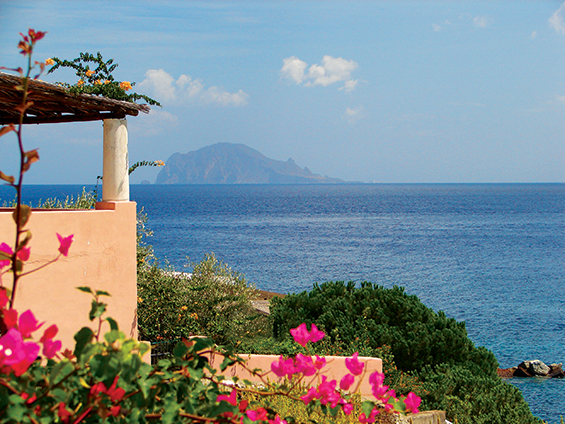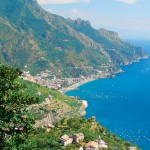Al fresco, or open-air dining, is a great way to enjoy a long, leisurely meal outdoors on a bright, sunny, breezy day or a balmy, sultry evening. Dining al fresco in the spring and summer months can be particularly relaxing, especially as the evening cools down, the crickets begin to chirp and the stars begin to twinkle in the night sky. Eating poolside or seaside can be a delight, especially with light, refreshing meals. Collected from around the globe, this set of al fresco recipes will grace a picnic table as well as a picnic basket.
From the Italian countryside to the Tropical North of Australia to the Lesser Antilles of the Caribbean, we will taste flavorful inventions which are quick and easy to prepare, to allow more time to enjoy dinner out on the patio and less time in the kitchen. From Parisian sidewalk cafés to oceanside terraces, these dishes lend themselves admirably to outdoor dining, city or country, elegant or casual, for the well-heeled or the barefoot, by sunset or candlelight.
This al fresco dinner consists of a distinctive appetizer of Prosciutto and Melone from the countryside of Italy, a savory main course of Veal Oscar with Avocados from Tropical North Queensland of Australia, to drink, the refreshing West Indian potion, The Sting, followed by an simple but tasty fruit dish of Pineapples with Blueberries and Apricot Brandy. The fresh air sharpens our appetite for the flavors that await us, so let us begin!
La Campagna – The Italian Countryside
The Italians are famous for dining al fresco. A long sturdy table is brought outside onto the terrace or right out in the field, especially in the countryside, and the family stays outside most of the day not far from the table. Lableless bottles of local red wine are poured, grown from the vineyards of the region, for a vineyard is never too far away in Italy. There will always be an abundance of dishes to delight the palate, such as the interesting flavor combination Prosciutto and Melone, which has graced tables in Italy for years. And such popular dishes have migrated to many other parts of the world and are often menu selections in restaurants of every caliber, from a terrace in Ravello overlooking the cool blue Mediterranean of the Amalfi Coast. The saltiness of the ham contrasting with the light sweetness of the melon provides a distinctive and colorful pairing. Also great for a picnic, at the lake or the beach, Prosciutto and Melone.
Surf and Turf – Aussie Style
The Australians, or Aussies as they are often called, in Tropical North Queensland have a myriad of culinary possibilities in terms of fresh seafood dishes. Set against the 1200-mile-long Great Barrier Reef, teeming with more varieties of fish than anywhere else in the world, and probably more sharks, the people of the Deep North, as they are fondly known, prepare succulent seafood dishes. With Moreton Bay Bugs, a local variety of lobster, and the freshest oysters that can be found anywhere, the Aussies go much further than the infamous Shrimp on the Barbie. In fact, when it comes to beef, lamb, and veal, the Aussies demonstrate admirable creativity. With more open range than almost anywhere on earth, the Aussies tend to their sprawling sheep and cattle stations under the hot sun that bakes the Outback, shielded by their distinctive Australian Akubra hats. Although many Aussie dishes are influenced by traditional English fare, more cosmopolitan cities such as Sydney and Melbourne offer a sort of nouvelle cuisine, Aussie-style, reflecting the many influences that have shaped this young and rugged land. Combined with the light Australian wines that are increasingly finding their way across the Pacific to our shores, as well as the emerging New Zealand wines, these dishes are further enhanced. In this dish of Veal with Crabmeat and Avocado, from Palm Cove, North Queensland, the presentation of ripe green avocado with the veal and crabmeat offers a colorful and refreshing entrée. Beachside at the edge of the Coral Sea not far from Cape Tribulation, with a view to the offshore Great Barrier Reef islands Captain Cook first discovered during the voyage of discovery of 1770, this dish takes on a character of its own.
And On to The Tropics
The people of the islands have produced sugar cane for centuries from the endless fields of green cane swaying in the sunny Caribbean breeze. And through the centuries, as evidenced by the crumbling stone mills from the thriving days of the sugar trade, they have produced some of the finest rums – dark rums, light rums, coconut rums – coveted by the many swashbuckling pirates that once threatened the seas. Among the many refreshing drinks with tropical fruit juices concocted throughout the islands to cool the fierce rays of the Caribbean sun, my favorite is the Sting, first introduced to me on the beautiful Caribbean island of Nevis in the Lesser Antilles. This island was named by Christopher Columbus on his second voyage in 1493, from the Spanish “nieves” or “snows,” as the volcano of the island is almost always crowned with a large white cumulus cloud. This cloud hovers even today, as seen from the neighboring island of St. Kitts, or St. Christopher, and island so beautiful Christopher Columbus named it after himself. The Kittitians customarily use their own CSR Rum, or Cane Spirit Rothchilds, (also referred to as Cane Sugar Rum), and the West Indian soft drink Ting, which is a light, refreshingly sweet grapefruit soft drink. In trying to reproduce this drink out of the islands, tangelo juice seemed to provide a good substitute for Ting. Enjoyed at the Nisbet Plantation, home of the wife of Lord Nelson, not far from Hurricane Bungalows, the Sting.









